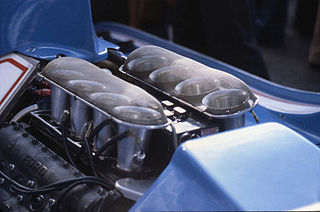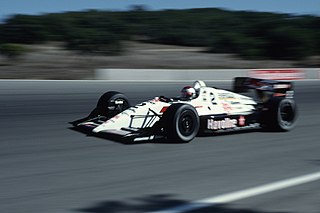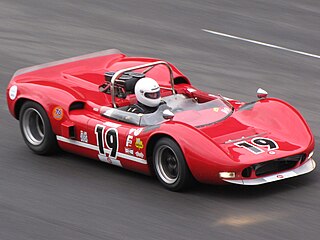
The Ford GT40 is a high-performance mid-engined racing car originally designed and built for and by the Ford Motor Company to compete in 1960s European endurance racing. Its specific impetus was to best Scuderia Ferrari, which had won the prestigious 24 Hours of Le Mans race for six years running from 1960 to 1965. Around 100 cars have been made, mostly as 289 cu in (4.7 L) V8-powered Mk Is, some sold to private teams or as road legal Mk III cars. Racing started in 1964, with Ford winning World Championships categories from 1966 to 1968. The first Le Mans win came in 1966 with three 427 cu in (7.0 L) powered Mk.II prototypes crossing the finish line together, the second in 1967 by a similarly powered highly modified US-built Mk.IV "J-car" prototype. In order to lower ever-higher race top speeds, a rule change from 1968 onwards limited prototypes to 3.0 litre Formula 1 engines; a loophole, however, allowed the private JW "Gulf Oil" team win at Le Mans in 1968 and 1969 running a Mk.I with a 5.0 litre engines.
Power-to-weight ratio is a calculation commonly applied to engines and mobile power sources to enable the comparison of one unit or design to another. Power-to-weight ratio is a measurement of actual performance of any engine or power source. It is also used as a measurement of performance of a vehicle as a whole, with the engine's power output being divided by the weight of the vehicle, to give a metric that is independent of the vehicle's size. Power-to-weight is often quoted by manufacturers at the peak value, but the actual value may vary in use and variations will affect performance.

Cosworth is a British automotive engineering company founded in London in 1958, specialising in high-performance internal combustion engines, powertrain, and electronics for automobile racing (motorsport) and mainstream automotive industries. Cosworth is based in Northampton, England, with facilities in Cottenham, England, Silverstone, England, and Indianapolis, IN, US.

A muscle car is an American-made two-door sports coupe with a powerful engine, generally designed for high-performance driving.
Lola Cars Limited is a British automobile manufacturer founded in 1958 by Eric Broadley in Bromley, England. The company is now owned by Till Bechtolsheimer, which he purchased in 2022. Lola Cars endured for more than fifty years to become one of the oldest and largest manufacturers of racing cars in the world. Lola started by building small front-engine sports cars, and branched out into Formula Junior cars before diversifying into a wider range of sporting vehicles. In 2012, Lola Cars stopped operations. Lola is set to make a return to motorsport in 2024 by joining the Formula E World Championship as an entrant and a powertrain supplier in a technical partnership with Yamaha.

The DFV is an internal combustion engine that was originally produced by Cosworth for Formula One motor racing. The name is an abbreviation of Double Four Valve, the engine being a V8 development of the earlier four-cylinder FVA, which had four valves per cylinder.

The Cooper T54 is a rear-engined open-wheel race car chassis, designed, developed, and built by Cooper, for U.S.A.C. Indy car racing, between 1961 and 1963. It was powered by a 250 hp (190 kW) 2.75 L (168 cu in) Coventry Climax FPF four-cylinder, but later used an Aston Martin six-cylinder engine, installed by automotive mechanic and engineer Joe Huffaker, after the car had been by Jim Kimberly to Kjell Qvale. After competing in IndyCar racing, it competed in a variety of different motorsports, including sprint car racing, where it was powered by larger Ford, Buick, and Chevrolet V8 engines.

The Ilmor 265-A is a turbocharged, 2.65 L (162 cu in), V-8 Indy car racing engine, designed and developed by Ilmor, for use in the CART PPG Indy Car World Series; between 1986 and 1993.

The Buick Indy V6 engine is a powerful turbocharged, 3.0–3.4 L (180–210 cu in), V-6, Indy car racing internal combustion engine, designed and produced by Buick for use in the CART PPG Indy Car World Series, and later the IRL IndyCar Series; between 1982 and 1997. It shares the same architecture, and mechanical design, and is based on the Buick V6 road car engine. A slightly destroked 3.0-liter V6 engine was also used in the March 85G and March 86G IMSA GTP sports prototypes.
The Ford Indy V8 engine is a naturally-aspirated, DOHC, V-8, Indy car racing engine, initially specially designed by Ford for use by Team Lotus, to compete in the Indianapolis 500; from 1963 to 1967. This is the engine that gave Jim Clark the victory in 1965 with his Lotus 38 chassis, Graham Hill victory in 1966 with his Lola T90 chassis, and A. J. Foyt the win at Indianapolis in 1967, in his Coyote 67 chassis.

The Lola T90/00 is a highly successful open-wheel racing car chassis, designed and built by Lola Cars that competed in the CART open-wheel racing series, for competition in the 1990 season. It was extremely competitive, winning a total of 12 races that season, including a win for Dutchman Arie Luyendyk at the prestigious Indianapolis 500. It also gave American Al Unser Jr. his first of two IndyCar World Championships, with Galles-Kraco Racing. It was powered by the 735–800 hp (548–597 kW) Ilmor-Chevrolet 265-A turbo engine.
The Lola T150, and it's the derivatives, the T152 and T153, were open-wheel racing car chassis, designed and built by Lola Cars to compete in USAC IndyCar racing series, between 1968 and 1970. The T150 and T153 were powered by the 159 cu in (2.61 L) 780–900 hp (580–670 kW) Ford Indy V-8 turbo engine; while the T152 chassis used a 159 cu in (2.61 L) 900 hp (670 kW) Offenhauser 4-cylinder turbo engine. Both the T150 and T152 used a unique four-wheel-drive system, which would be banned after the 1969 season. The T153 only used a conventional two-wheel-drive (rear-wheel-drive setup. The different chassis would, over the span of three years, win a total of 9 races, all while being driven by Al Unser.

The Lola T91/00 is a highly successful open-wheel racing car chassis, designed and built by Lola Cars that competed in the CART open-wheel racing series, for competition in the 1991 IndyCar season. It was the most dominant car that season, and extremely competitive, winning a total of 14 out of the 17 races during the 1991 season, with Michael Andretti enjoying the most considerable success, scoring 8 wins, taking 8 pole positions, and leading more laps than any other driver that season. Al Unser Jr. and Arie Luyendyk scored 2 wins, while Bobby Rahal and John Andretti scored one win each. Even though Bobby Rahal won only one race, he had 11 podium finishes, and 13 top 10s, making him a very serious challenger and competitor for the title that year. Michael Andretti eventually went on to win the 1991 IndyCar World Drivers' Championship with this car. It was powered by the 720–800 hp (540–600 kW) Ilmor-Chevrolet 265-A turbo engine.

The March 85C is an open-wheel race car, designed by Adrian Newey, and built by March Engineering, to compete in the 1985 IndyCar season. March would win 10 out of the 15 races that season, along with taking 12 pole positions. Newey's March 85C chassis would clinch the 1985 IndyCar championship in the hands of Al Unser, and the 1985 Indianapolis 500 with Danny Sullivan, with his famous "spin-and-win." It was powered by the Buick Indy V6 turbo engine, which powered Pancho Carter to pole position, and Scott Brayton to second position at the Indianapolis 500, sweeping the top two spots, and the Ford-Cosworth DFX turbo V8 engine.

The Lola T160, and its evolution, the Lola T165, is a series of purpose-built Group 7 sports prototype race cars, designed and developed by British chassis manufacturer Lola Cars, specifically to compete in the Can-Am series in 1968. It was the successor to the competitive T70, sharing similar design knowledge and cues. Lola built the chassis, constructed out of fiberglass, and molded into an aluminum monocoque. This meant the car was light was lightweight, weighing only 670 kg (1,480 lb). The chassis was designed to accept a small-block engine, but most cars were powered by either the Chevrolet ZL1 or the Ford FE "big-block" motors, generating about 625–750 hp (466–559 kW); mated to a 4-speed or 5-speed Hewland L.G.500 or L.G.600 manual transmission. This made the cars very fast, with a notably excellent power-to-weight ratio. It was used in active competition until 1971, and was succeeded and used alongside the new T220 in 1970.

The Lola Mk1 is the first sports racing car made by Lola, under the leadership and guidance of Eric Broadley, in 1958. The body was designed and developed by chief stylist Maurice Gomm, made out of a steel or fiberglass tubular spaceframe chassis, covered in a low-profile, sleek, aluminum skin. The 80 hp (60 kW), 1,098 cc (67.0 cu in), Coventry Climax FWA four-cylinder engine was designed by Harry Mundy and Walter Hassan. The car used a 4-speed manual transmission, and was lightweight, weighing in at a mere 812–840 lb (368–381 kg). It also notably won its class at the 1960 12 Hours of Sebring, being driven by Charles Vögele and Peter Ashdown. At least 32 cars were known to have been built, but the actual number is believed to be between 38 and 42.

The Lola B03/51 is an open-wheel formula racing car, designed, developed and built by Lola for the Japanese Formula Nippon championship series, in 2003. It was powered by a naturally aspirated 3,000 cc (180 cu in) Mugen MF308 engine that produced around 550 hp (410 kW) @ 13,500 rpm.

The McLaren M1A, and its derivatives, the McLaren M1B and the McLaren M1C, are a series of mid-engined Group 7 sports prototype race cars built by McLaren, between 1963 and 1968.
The Lola T80 was an open-wheel race car, developed and built by British manufacturer Lola, and designed by Eric Broadley, in 1965. Its best race result and position was a 4th-place finish, at Trenton in 1965; being driven by American Bud Tingelstad. Its best result at the Indianapolis 500 was a 9th-place finish, with Al Unser driving at the 1965 race. It was powered by the Ford quad-cam DOHC Indy V8 engine, developing around 425 hp (317 kW) @ 8,000 rpm. It was used alongside, and eventually succeeded, by the T90.
The Lola F3000 cars is a series of open-wheel formula race cars, designed, developed and built by British manufacturer Lola.













